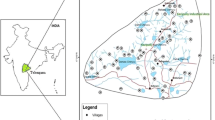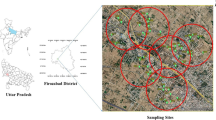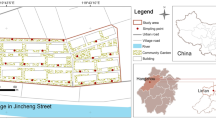Abstract
The present study aims to appraise the spatial distribution of potential toxic metals by using geostatistical technique and find their associated ecological and human health risks from surface soils of Durgapur industrial area, India. The results show that the mean metal concentrations are 116.03, 32.96, 154.37, 321.20, 50.08, 29.54 and 2.97 mg/kg for Pb, Cd, Cr, Fe, Cu, Ni and Hg, respectively, and majority of them is found higher than their background and world natural soil concentrations. The GIS contour map of pollution load index values clearly distinguished the studied sampling area is highly to very highly polluted by the toxic metals. Contamination factor (Cf) and geo-accumulation index (Igeo) values of studied metals show a similar sequence of Hg > Cd > Pb > Fe > Cr > Ni > Cu. Calculated enrichment factor (EF) value for Hg (13.29), Cd (5.26) and Pb (1.11) in studied soils was found significantly higher, which suggests that their primary sources are higher industrial activities in the studied area. Computation of potential ecological risk index reveals that the entire study area is under high risk level (1941.60–3367.23), in which Cd (588.52) and Hg (1979.26) possess the maximum ecological risk factor in all the sampling sites. The results of correlation analysis, principle component analysis and cluster analysis explore that industrial discharges, atmospheric disposition and waste disposal are the major sources of soil metal pollution in the studied region. Human health hazard indices are lower than 1 for all metals, indicating low non-carcinogenic risks to children and adults. Carcinogenic risk assessment reveals the existence of cancer risk of Cd (5.5E−03), Cr (8.6E−04) and Ni (3.0E−04) to child and Cd (8.2E−04) and Cr (1.3E−04) to adults in Durgapur.






Similar content being viewed by others
References
Acosta, J. A., Faz, C. A., Arocena, J. M., Debela, F., & Martinez-Martinez, S. (2009). Distribution of metals in soil particle size fractions and its implication to risk assessment of playgrounds in Murcia City (Spain). Geoderma, 149, 101–109.
Adriano, D. C. (1986). Trace elements in the terrestrial environments: Biogeochemistry, bioavailability, and risks of metals (p. 533). New York: Springer.
Adriano, D. (2001). Trace elements in terrestrial environments: Biogeochemistry, bioavailability, and risks of metals (2nd ed., p. 866). New York: Springer.
Ahmad, M. K., Islam, S., Rahman, M. S., Haque, M. R., & Islam, M. M. (2010). Heavy metals in water, sediment and some fishes of Buriganga River, Bangladesh. International Journal of Environmental Research, 4(2), 321–332.
Al-Khashman, O. A. (2012). Assessment of heavy metal accumulation in urban soil around Potash industrial site in the east of the Dead Sea and their environmental risks. Soil and Sediment Contamination: An International Journal, 21(2), 276–290.
Al-Khashman, O., & Shawabkeh, R. (2006). Metal distribution in soils around the cement factory in southern Jordan. Environmental Pollution, 140, 387–394.
Alsbou, E. M. E., & Al-Khashman, O. A. (2018). Heavy metal concentrations in roadside soil and street dust from Petra region, Jordan. Environmental Monitoring and Assessment, 190, 48–60.
Banerjee, U. S., & Gupta, S. (2013). Impact of industrial waste effluents on river damodar adjacent to Durgapur industrial complex, West Bengal, India. Environmental Monitoring and Assessment, 185, 2083–2094.
Barkett, M. O., & Akün, E. (2018). Heavy metal contents of contaminated soils and ecological risk assessment in abandoned copper mine harbor in Yedidalga, Northern Cyprus. Environmental Earth Sciences, 77, 378–391.
Barman, S. C., Sahu, R. K., Bhargava, S. K., & Chatterjee, C. (2000). Distribution of heavy metals in wheat, mustard, and weed grown in fields irrigated with industrial effluents. Bulletin of Environmental Contamination and Toxicology, 64, 489–496.
Bhuiyan, M. A. H., Parvez, L., Islam, M. A., Dampare, S. B., & Suzuki, S. (2010). Heavy metal pollution of coal mine-affected agricultural soils in the northern part of Bangladesh. Journal of Hazardous Materials, 173, 384–392.
Bouyoucos, G. J. (1951). A recalibration of the hydrometer method for making mechanical analysis of soils. Agronomy Journal, 43(9), 434–438.
Bowen, H. J. M. (1979). Environmental chemistry of the elements. Waltham, MA: Academic Press.
Cao, Z., Chen, Q., Wang, X., Zhang, Y., Wang, S., Wang, M., et al. (2018). Contamination characteristics of trace metals in dust from different levels of roads of a heavily air-polluted city in north China. Environmental Geochemistry and Health, 40, 2441–2452. https://doi.org/10.1007/s10653-018-0110-3.
Census (2011). Population Census of India is Collection of Census Data Reports by Govt of India. (http://censusindia.gov.in/2011-Common/CensusData2011.html.).
Chabukdhara, M., & Nema, A. K. (2013). Heavy metals assessment in urban soil around industrial clusters in Ghaziabad, India: Probabilistic health risk approach. Ecotoxicology and Environmental Safety, 87, 57–64.
Charlesworth, S., Everett, M., McCarthy, R., OrdSQez, A., & De Miguel, E. (2003). A comparative study of heavy metal concentration and distribution in deposited street dusts in a large and a small urban area: Birmingham and Coventry, West Midlands, UK. Environment International, 29, 563–573.
Chen, H., Teng, Y., Lu, S., Wang, Y., & Wang, J. (2015). Contamination features and health risk of soil heavy metals in China. Science of the Total Environment, 512, 143–153.
Ćujić, M., Dragović, S., Đorđević, M., Dragović, R., & Gajić, B. (2016). Environmental assessment of heavy metals around the largest coal fired power plant in Serbia. Catena, 139, 44–52.
Ferreira-Baptista, L., & De-Miguel, E. (2005). geochemistry and risk assessment of street dust in Luanda, Angola. A Tropical Urban Environment. Atmospheric Environment, 39, 4501–4512.
Gao, H., Bai, J., Xiao, R., Liu, P., Jiang, W., & Wang, J. (2013). Levels, sources and risk assessment of trace elements in wetland soils of a typical shallow freshwater lake, China. Stochastic Environmental Research and Risk Assessment, 27, 275–284.
Ghrefat, H. A., Yusuf, N., Jamarh, A., & Nazzal, J. (2012). Fractionation and risk assessment of heavy metals in soil samples collected along Zerqa River, Jordan. Environmental Earth Sciences, 66, 199–208.
Gope, M., Masto, R. E., George, J., & Balachandran, S. (2018). Tracing source, distribution and health risk of potentially harmful elements (PHEs) in street dust of Durgapur, India. Ecotoxicology and Environmental Safety, 154, 280–293.
Gope, M., Reginald, E. M., Joshy, G., Raza, G. R. H., & Srinivasan, B. (2017). Bioavailability and health risk of some potentially toxic elements (Cd, Cu, Pb and Zn) in street dust of Asansol, India. Ecotoxicology and Environmental Safety, 138, 231–241.
Guney, M., Zagury, G. J., Dogan, N., & Onay, T. T. (2010). Exposure assessment and risk characterization from trace elements following soil ingestion by children exposed to playgrounds, parks and picnic areas. Journal of Hazardous Materials, 182, 656–664.
Guo, G., Wu, F., Xie, F., & Zhang, R. (2012). Spatial distribution and pollution assessment of heavy metals in urban soils from southwest China. Journal of Environmental Sciences, 24, 410–418.
Gupta, S., Satpati, S., Nayek, S., & Garai, D. (2010). Effect of wastewater irrigation on vegetables in relation to bioaccumulation of heavy metals and biochemical changes. Environmental Monitoring and Assessment, 165, 169–177.
Gupta, S., Satpati, S., Saha, R. N., & Nayek, S. (2013). Assessment of spatial and temporal variation of pollutants along a natural channel receiving industrial wastewater. International Journal of Environmental Engineering, 5(1), 52–69.
Hakanson, L. (1980). An ecological risk index for aquatic pollution control. A Sedimentological Approach. Water Research, 14, 975–1001.
Hamad, S. H., Schauer, J. J., Shafer, M. M., Al-Rheem, E. A., Skaar, P. S., Heo, J., et al. (2014). Risk assessment of total and bioavailable potentially toxic elements (PTEs) in urban soils of Baghdad, Iraq. Science of the Total Environment, 494–495, 39–48.
Hossain, M. A., Ali, N. M., Islam, M. S., & Hossain, H. Z. (2014). Spatial distribution and source apportionment of heavy metals in soils of Gebeng industrial city, Malaysia. Environmental Earth Sciences, 73, 115–126.
Hu, Y., Liu, X., Bai, J., Shih, K., Zeng, E. Y., & Cheng, H. (2013). Assessing heavy metal pollution in the surface soils of a region that had undergone three decades of intense industrialization and urbanization. Environmental Science and Pollution Research, 20, 6150–6159.
Islam, M. S., Proshad, R., & Ahmed, S. (2018). Ecological risk of heavy metals in sediment of an Urban River in Bangladesh. Human and Ecological Risk Assessment: An International Journal, 24(3), 699–720.
Kabata-Pendias, A. (2011). Trace elements in soils and plants (4th ed.). Milton Park, FL : Taylor and Francis Group, LLC. https://doi.org/10.1017/S0014479711000743.
Khillare, P. S., Balachandran, S., & Meena, B. R. (2004). Spatial and temporal variation of heavy metals in atmospheric aerosol of Delhi. Environmental Monitoring and Assessment, 90, 1–21.
Khillare, P. S., Jyethi, D. S., & Sarkar, S. (2012). Health risk assessment of polycyclic aromatic hydrocarbons and heavy metals via dietary intake of vegetables grown in the vicinity of thermal power plants. Food and Chemical Toxicology, 50, 1642–1652.
Kisku, G. C., Pandey, P., Negi, M. P. S., & Misra, V. (2011). Uptake and accumulation of potentially toxic metals (Zn, Cu and Pb) in soils and plants of durgapur industrial belt. Journal of Environmental Biology, 32, 831–838.
Krishna, A. K., & Mohan, K. R. (2016). Distribution, correlation, ecological and health risk assessment of heavy metal contamination in surface soils around an industrial area, Hyderabad, India. Environmental Earth Sciences, 75, 411–427.
Laing, G. D., Meyer, B. D., Meers, E., Lesage, E., Moortel, A. V. D., Tack, F. M. G., et al. (2008). Metal accumulation in intertidal marshes: Role of sulphide precipitation. Wetlands, 28, 735–746.
Liu, L., Zhang, X., & Zhong, T. (2015). Pollution and Health risk assessment of heavy metals in urban soil in China. Human and Ecological Risk Assessment: An International Journal, 22, 424–434.
Machender, G., Dhakate, R., Prasanna, L., & Govil, P. K. (2011). Assessment of heavy metal contamination in soils around Balanagar industrial area, Hyderabad, India. Environmental Earth Sciences, 63, 945–953.
Muller, G. (1969). Index of geoaccumulation in sediments of the rhine river. GeoJournal, 2, 108–118.
Nayek, S., Gupta, S., & Saha, R. N. (2010). Metal accumulation and its effects in relation to biochemical response of vegetables irrigated with metal contaminated water and wastewater. Journal of Hazardous Materials, 178, 588–595.
Nayek, S., Gupta, S., Saha, R. N., & Satpati, S. (2011). Heavy metal translocation in soil near to the effluent discharge channel of industrial complex, West Bengal, India. Asian Journal of Water, Environment and Pollution, 8(2), 11–16.
Nayek, S., Roy, S., Dutta, S., Saha, R. N., & Chakraborty, T. (2013). Dynamics of metal distribution in cultivated soil and vegetables in vicinity to industrial deposition: An inference to chemical contamination of food Chain. International Journal of Chemoinformatics and Chemical Engineering, 3(2), 117–124.
Pastrana-Corral, M. A., Wakida, F. T., Temores-Peña, J., Rodriguez-Mendivil, D. D., García-Flores, E., Piñon-Colin, T. D. J., et al. (2017). Heavy metal pollution in the soil surrounding a thermal power plant in Playas de Rosarito, Mexico. Environmental Earth Sciences, 76, 583–591.
Pathak, A. K., Kumar, R., Kumar, P., & Yadav, S. (2015). Sources apportionment and spatiotemporal changes in metal pollution in surface and sub-surface soils of a mixed type industrial area in India. Journal of Geochemical Exploration, 159, 169–177.
Pobi, K. K., Nayek, S., & Saha, R. N. (2017). Assessment of heavy metals in water, sediment and adjacent soil of a contaminated channel in durgapur industrial zone, West Bengal, India. International Journal of Ecology and Environmental Sciences, 43(4), 275–285.
Pobi, K. K., Satpati, S., Dutta, S., Nayek, S., Saha, R. N., & Gupta, S. (2019). Sources evaluation and ecological risk assessment of heavy metals accumulated within a natural stream of Durgapur industrial zone, India, by using multivariate analysis and pollution indices. Applied Water Science, 9, 58–73.
Reeuwijk, L. P. (Ed.). (1995). Procedure for Soil Analysis, 5th edn. ISRIC Technical Paper 9. Wageningen. https://www.scirp.org/(S(351jmbntvnsjt1aadkposzje))/reference/ReferencesPapers.aspx?ReferenceID=43229.
Rhoades, D. (1982). Soluble salts. In Page, A. L., Miller, R. H., & Keeney, D. R. (Eds.), Methods of soil analysis, part II, 2nd edn. Madison, WI, USA: American Society of Agronomy. http://ucce.ucdavis.edu/universal/printedprogpageshow.cfm?pagenum=0&progkey=1360&county=5120.
Severini, M. D. F., Carbone, M. E., Villagran, D. M., & Marcovecchio, J. E. (2018). Toxic metals in a highly urbanized industry-impacted estuary (Bahia Blanca Estuary, Argentina): Spatio-temporal analysis based on GIS. Environmental Earth Sciences, 77, 393–411.
Shen, F., Liao, R., Ali, A., Mahar, A., Guo, D., Li, R., et al. (2017). Spatial distribution and risk assessment of heavy metals in soil near a Pb/Zn smelter in Feng County, China. Ecotoxicology and Environmental Safety, 139, 254–262.
Sofianska, E., & Michailidis, K. (2015). Chemical assessment and fractionation of some heavy metals and arsenic in agricultural soils of the mining affected Drama plain, Macedonia, Northern Greece. Environmental Monitoring and Assessment, 187, 101–116.
Sutherland, R. A. (2000). Bed sediment-associated trace metals in an urban stream, Oahu. Hawaii. Environmental Geology, 39(6), 611–627. https://doi.org/10.1007/s002540050473.
Tomlinson, D. L., Wilson, J. G., Harris, C. R., & Jeffrey, D. W. (1980). Problems in the assessment of heavy-metal levels in estuaries and the formation of a pollution index. Helgolander Meeresunters, 33, 566–575.
USEPA, (United States Environmental Protection Agency). (1989). Risk Assessment Guidance for Superfund, Vol. I: Human Health Evaluation Manual. EPA/540/1-89/002. Office of Solid Waste and Emergency Response.
USEPA, (United States Environmental Protection Agency). (2001). Risk Assessment Guidance for Superfund: Volume III—Part A, Process for Conducting Probabilistic Risk Assessment. EPA 540-R-02-002. Washington, D.C.:US Environmental Protection Agency.
USEPA, Method 3051a. (2007). Microwave assisted acid dissolution of sediments, sludges, soils, and oils, revision 1. Washington, DC: United States Environmental Protection Agency.
Walkley, A., & Black, I. A. (1934). An Examination of Degtjareff method for determining soil organic matter and a proposed modification of the chromic acid titration method. Soil Science, 37, 29–37.
Wang, G., Zhang, S., Xiao, L., Zhong, Q., Li, L., Xu, G., et al. (2017). Heavy metals in soils from a typical industrial area in sichuan, china: Spatial distribution, source identification, and ecological risk assessment. Environmental Science and Pollution Research, 24, 16618–16630.
Wedepohl, K. H. (1986). Geochemistry in Handbook of geochemistry. Berlin, Heidelberg: Springer.
Yu, J., Huang, Z., Chen, T., Qin, D., Zeng, X., & Huang, Y. (2011). Evaluation of ecological risk and source of heavy metals in vegetable-growing soils in Fujian Province, China. Environmental Earth Sciences, 65, 29–37.
Zhang, C., Qiao, Q., Piper, J. D. A., & Huang, B. (2011). Assessment of heavy metal pollution from a fe-smelting plant in urban river sediments using environmental magnetic and geochemical methods. Environmental Pollution, 159, 3057–3070.
Zhao, L., Xu, Y., Hou, H., Shangguan, Y., & Li, F. (2014). Source identification and health risk assessment of metals in urban soils around the Tanggu chemical industrial district, Tianjin, China. Science of the Total Environment, 468–469, 654–662.
Acknowledgements
Authors sincerely acknowledge DST-FIST (SR/FST/CSI-267/2015 (C)) and National Institute of Technology (NIT), Durgapur, for creating and providing infrastructural facilities throughout the research work. Authors also greatly acknowledge DST, GOI, for partial financial support (Project No. SB/EMEQ-115/2013 dated 08.07.2013).
Author information
Authors and Affiliations
Corresponding author
Additional information
Publisher's Note
Springer Nature remains neutral with regard to jurisdictional claims in published maps and institutional affiliations.
Rights and permissions
About this article
Cite this article
Pobi, K.K., Nayek, S., Gope, M. et al. Sources evaluation, ecological and health risk assessment of potential toxic metals (PTMs) in surface soils of an industrial area, India. Environ Geochem Health 42, 4159–4180 (2020). https://doi.org/10.1007/s10653-020-00517-2
Received:
Accepted:
Published:
Issue Date:
DOI: https://doi.org/10.1007/s10653-020-00517-2




